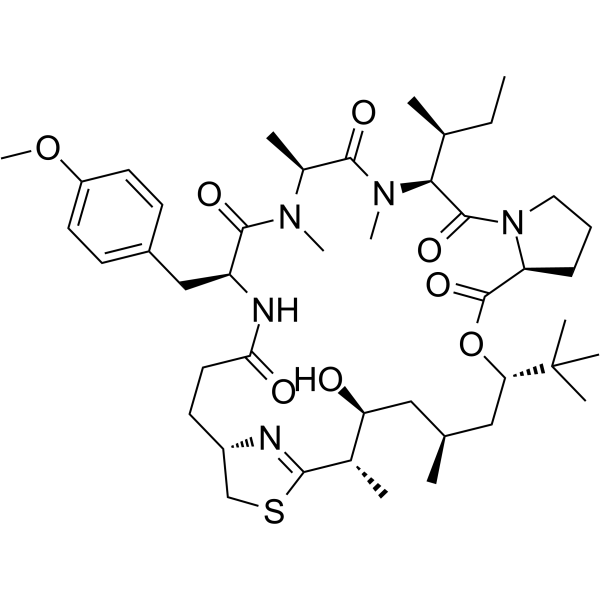| Description |
Apratoxin S4 (Apra S4) is a potent Sec61 inhibitor that prevents cotranslational translocation of secretory proteins into the endoplasmic reticulum (ER). Apratoxin S4 has antiviral effects against some flaviviruses with IC50 values ranging from 0.46 nM to 170 nM, and inhibits retinal vascular cell activation by suppressing multiple angiogenic pathways. Apratoxin S4 can be used for the research of viral infections, angiogenic diseases and cancers[1][2].
|
| Related Catalog |
|
| Target |
IC50: 0.17 μΜ (Vero E6), 0.71 nM (HeLa-hACE2)[1].
|
| In Vitro |
Apratoxin S4 (Apra S4, 0-0.1 mM, 1h or 2 h) reduces viral (SARS-CoV-2) replication in Vero E6, HeLa-hACE2 and human pneumocyte-like cells, with IC50 values of 0.17 μΜ (Vero E6) and 0.71 nM (HeLa-hACE2)[1]. Apratoxin S4 (0-10 μΜ approximately, 2 h) has broad-spectrum antiviral effects against flaviviruses (Zika virus, Dengue virus, and West Nile virus) with IC50 values ranging from 0.46 nM to 170 nM, and has no negligible cytotoxicity[1]. Apratoxin S4 (0.1-2.5 μΜ, 0-72 h) reduces SARS-CoV-2 multicycle growth by Sec61-mediated way, and impacts on post-entry steps[1]. Apratoxin S4 (0-1 μΜ, 1-18 h) inhibits formation of double-membrane vesicles and RNA replication[1]. Apratoxin S4 (1 μΜ, 2 h) reduces production and trafficking of secretory pathway dependent proteins in Vero CCL81 cells[1].Apratoxin S4 (25 nM, 24 h) inhibits the activation of HRECS cells to form tube-like structure[2]. Immunofluorescence[1] Cell Line: Vero E6 cells, HeLa-hACE2 cells (HeLa cells transduced with human ACE2), human pneumocyte-like cells derived from human stem cells. Concentration: 0-0.1 mM Incubation Time: 2 h prior to infection (SARS-CoV-2 for 16 h) Result: Reduced viral replication in a concentration-dependent manner, with IC50 values of 0.17 μΜ (Vero E6) and 0.71 nM (HeLa-hACE2), and with nearly 100% inhibition of viral replication at 2 nM. RT-PCR[1] Cell Line: Vero E6 cells Concentration: 0.1, 1 μM Incubation Time: 12 h Result: Reduced the negative-strand RNA with an IC50 of 0.1 μM, and reduced the presence of dsRNA intermediates in infected cells at 1 μM. Western Blot Analysis[1] Cell Line: Vero E6 cells, Calu-3 cell Concentration: 10 nM-10 μM Incubation Time: 12h, 24 h Result: Decreased viral glycoprotein expression in Vero E6 cells, and ACE2 protein levels in Vero E6 cells and Calu-3 cells.
|
| In Vivo |
Apratoxin S4 (Intraperitoneal injection, a single dose of 0.25 mg/kg, C57BL/6J mice) inhibits ocular angiogenesis in model of laser-Induced choroidal neovascularization (CNV)[2]. Apratoxin S4 (Intravitreal injection, a single dose of 1.7 μM per eye in vitreous, rabbits) inhibits the retinal neovascularization and leakage in persistent retinal neovascularization (PRNV) model[2]. Apratoxin S4 (Intraperitoneal injection at P12 and P15, 0.0625, 0.125, 0.25 mg/kg, oxygen-induced retinopathy mouse model) inhibits pathological neovascularization in the eye[2]. Animal Model: C57BL/6 mice model of laser-Induced choroidal neovascularization[2] Dosage: 0.25 mg/kg Administration: Intraperitoneal injection (a single dose) Result: Reduced neovascular response and CNV lesions in eyes. Animal Model: Rabbits with persistent retinal neovascularization (PRNV) model[2] Dosage: 1.7 μM per eye in vitreous Administration: Intravitreal injection (a single dose) Result: Inhibited the retinal neovascularization and leakage, and had no inflammation or corneal irritation. Animal Model: Oxygen-induced retinopathy (OIR) mouse model [2] Dosage: 0.0625, 0.125, 0.25 mg/kg Administration: Intraperitoneal injection at P12 and P15 Result: Inhibited the formation of disorganized neovascularization tufts and pericyte coverage in neovascular tufts, and had no effect on the size of the avascular region. Suppressed proangiogenic TGFβ1 signaling transducer, pSmad1/5/8, downstream mediator of VEGF signaling pathway, pERK, PDGFR-β expression in the retina of the mice.
|
| References |
[1]. Marie O Pohl, et al. Sec61 Inhibitor Apratoxin S4 Potently Inhibits SARS-CoV-2 and Exhibits Broad-Spectrum Antiviral Activity. ACS Infect Dis. 2022 Jul 8;8(7):1265-1279. [2]. Beiying Qiu, et al. Apratoxin S4 Inspired by a Marine Natural Product, a New Treatment Option for Ocular Angiogenic Diseases. Invest Ophthalmol Vis Sci. 2019 Jul 1;60(8):3254-3263.
|
